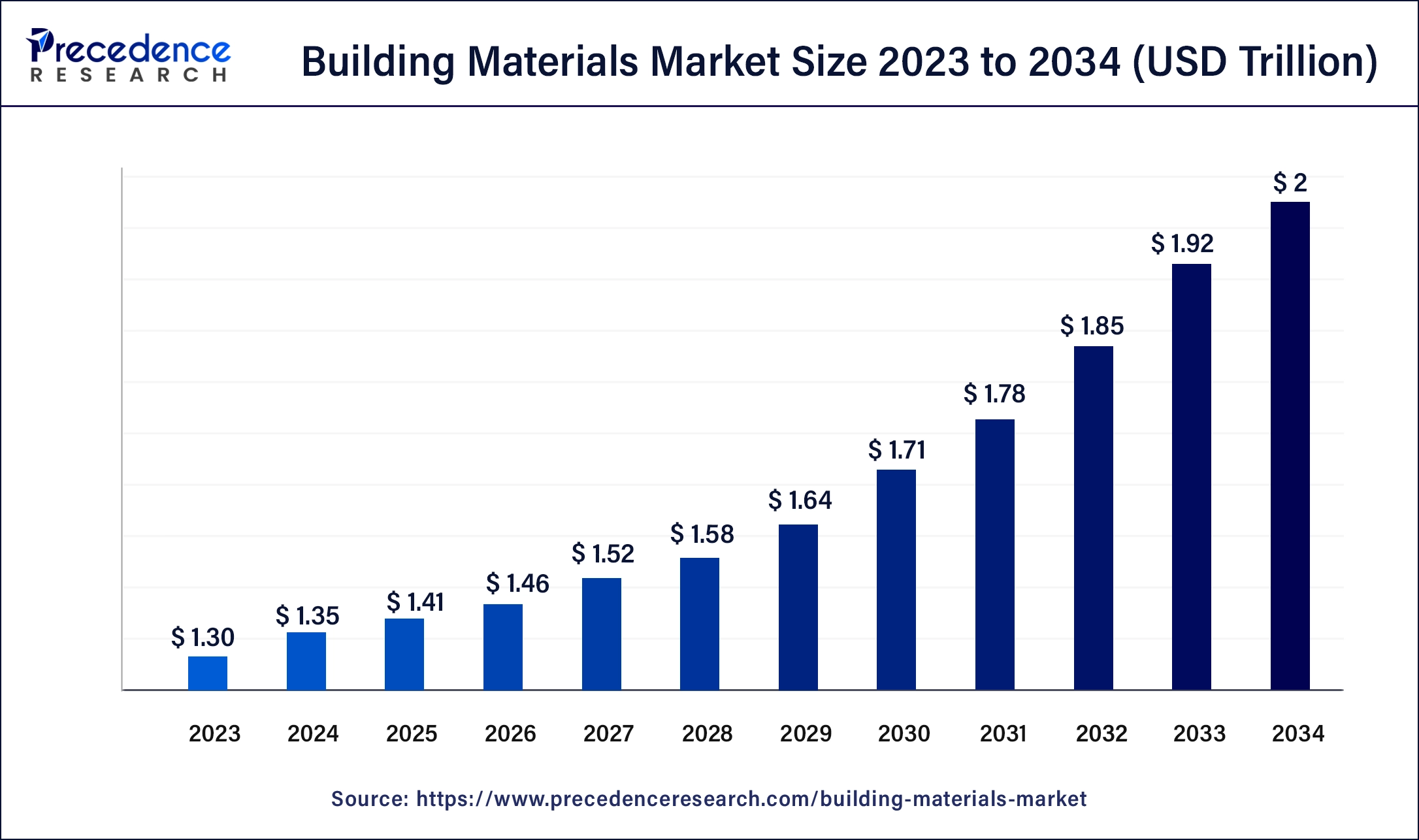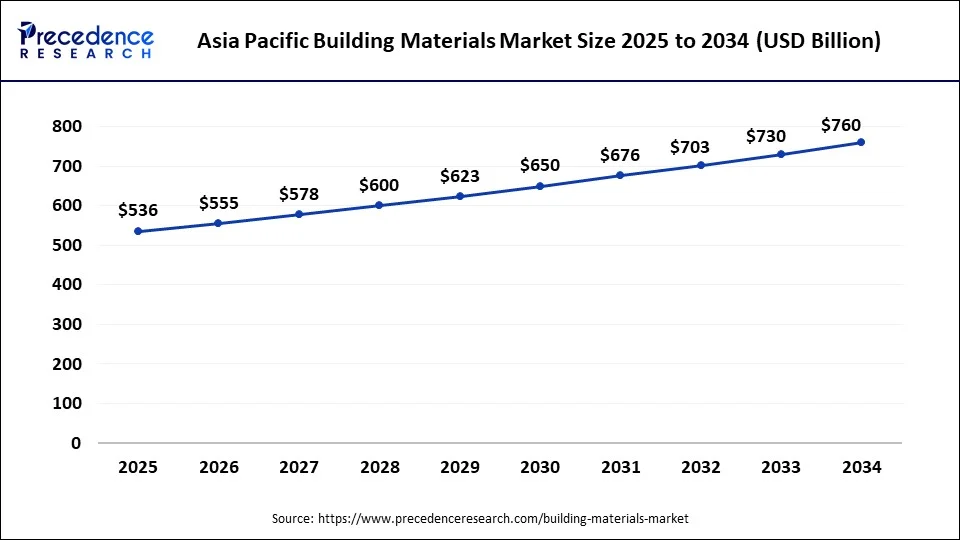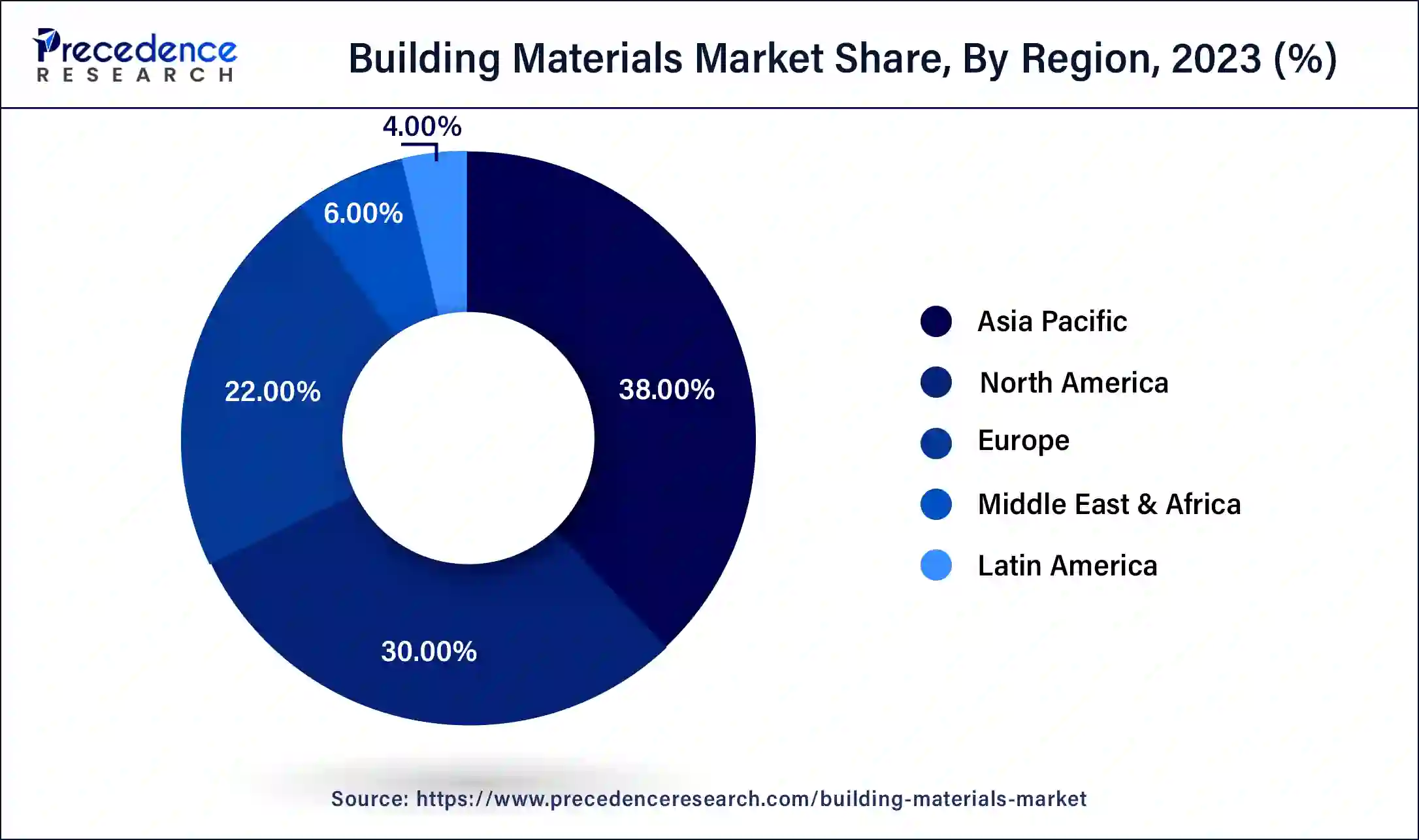Building Materials Market Size and Forecast 2025 to 2034
The global building materials market size accounted for USD 1.35 trillion in 2024, and is anticipated to hit around USD 1.41 trillion by 2025, and is expected to be worth around USD 2 trillion by 2034, at a CAGR of 4% from 2025 to 2034.

Building Materials Market Key Takeaways
- In terms of revenue, the building materials market is valued at USD 1.41 trillion in 2025.
- It is projected to reach USD 2 trillion by 2034.
- The building materials market is expected to grow at a CAGR of 4% from 2025 to 2034.
- Asia-Pacific contributed more than 38% of revenue share in 2023.
- North America is estimated to expand the fastest CAGR between 2024 and 2034.
- By type, the cement segment held the largest market share of 31% in 2024.
- By type, the concrete bricks segment is anticipated to grow at a remarkable CAGR of 4.7% between 2025 and 2034.
- By end-user, the residential segment generated over 30% of revenue share in 2024.
- By end-user, the industrial segment is expected to expand at the fastest CAGR over the projected period.
Asia Pacific Building Materials Market Size and Growth 2025 to 2034
The Asia Pacific building materials market size is estimated at USD 536 billion in 2025 and is predicted to be worth around USD 760 billion by 2034, at a CAGR of 4.2% from 2025 to 2034.

Asia-Pacific holds a major share of 38% in the building materials market due to rapid urbanization, population growth, and robust construction activities in countries like China and India.
- Approximately 178,000 new houses are projected to be constructed in Australia in the fiscal year 2025.
The region's expanding middle class and increased disposable income drive the demand for residential and commercial spaces. Additionally, government infrastructure investments contribute to market growth. The construction boom, coupled with a rising focus on sustainable building practices, positions Asia-Pacific as a key player in the building materials industry, attracting substantial investments and fostering market dominance.
The Chinese government announced its 2024 Budget in March 2024. The budget includes an expenditure of CNY28.6tn ($4tn) in 2024, which is an increase of 3.8% compared with the 2023 Budget. Additionally in March, the government announced it plans to invest CNY1.2tn ($173bn) in transport infrastructure projects by the end of this year.
In March 2024, Prime Minister of India Narendra Modi inaugurated and laid the foundation stone of 112 National Highway (NH) projects spread across the country worth over ₹1 lakh crore at Gurugram. The projects include development works from Karnataka, Kerala, and Andhra Pradesh in South India, Uttar Pradesh and Haryana in North India, West Bengal and Bihar in East India and Maharashtra, Punjab as well as Rajasthan in West India.
North America is projected to witness rapid growth in the building materials market due to increased construction activities, infrastructure development, and a surge in demand for sustainable and energy-efficient materials. The region's commitment to stringent building codes and environmental regulations is driving innovation in eco-friendly solutions. Moreover, a robust economy, urbanization, and the need for modernized infrastructure contribute to the market's upward trajectory. The growing emphasis on technology adoption and digitalization further positions North America as a key player in the evolving landscape of the building materials industry.
The $20 trillion U.S. economy is relying on a wide network of infrastructure which includes bridges, roads, ports, and freight rail. Considering the Inflation Reduction Act (IRA) and the Infrastructure Investment and Jobs Act (IIJA), the 117th Congress has invested $1.25 trillion for developing the infrastructure in the United States.
The O'Hare Modernization Program includes the expansion of terminals 3 and 5 and the creation of a new Global Terminal. Around $8.5 billion is expected to be spent on this expansion plan. Thus, rising expenditures on the modernization and expansion of existing airports in the U.S. is creating a high demand for the required construction materials.

Europe is experiencing notable growth in the building materials market due to a surge in construction activities, driven by urbanization, infrastructure development, and sustainable building practices. Stringent environmental regulations and a rising demand for energy-efficient and eco-friendly materials contribute to market expansion. Moreover, a focus on innovative construction technologies and the need for resilient and aesthetically pleasing materials further stimulate growth. The region's commitment to green building initiatives and the adoption of advanced construction methods position Europe as a dynamic and growing market in the building materials sector.
Market Overview
Building materials encompass a diverse array of substances used in construction to create structures ranging from residential homes to towering skyscrapers. These materials can be broadly categorized into natural, synthetic, and composite types. Natural materials, such as wood, stone, and clay, are derived directly from the Earth and have been fundamental to construction for centuries. They are appreciated for their aesthetic appeal and sustainability. Synthetic materials, such as plastics and metals, are man-made and often prized for their durability, versatility, and cost-effectiveness. Lastly, composite materials combine various elements to leverage the strengths of each constituent part, enhancing overall performance.
Building Materials Market Data and Statistics
- As of October 2022, the United States Green Building Council (USGBC) reported a tally of approximately 20,125 projects boasting Certified LEED status. Accompanying this were 21,068 projects attaining Silver recognition, 21,206 achieving Gold-level certification, and 7,027 reaching the pinnacle of Platinum distinction.
- The US Energy Information Administration's data reveals that the collective energy consumption of the residential and commercial sectors in 2021 amounted to 21 quadrillion Btu, constituting 28% of the nation's total end-use energy consumption. The heightened energy demand from buildings has spurred the US government to allocate USD 3.16 billion toward initiatives aimed at transforming approximately 450,000 homes in low-income areas into structures with enhanced energy efficiency, thereby curbing the nation's utility bills.
- Canada's commitment to combatting climate change involves a pledge to reduce total greenhouse gas (GHG) emissions to 40-45% below 2005 levels by 2030, ultimately striving for net-zero emissions by 2050. To facilitate these goals, the 2022 budget designates CAD 150 million for the development of the Canada Green Buildings Strategy, mobilizing nationwide endeavors to revolutionize markets and reduce associated costs.
- According to the World Green Building Council (WGBC), the most flourishing sector for green buildings in Canada pertains to new institutional construction. Currently, over one-third of all emerging projects in the country align with green standards, with this trend anticipated to gain substantial momentum in the years ahead.
- In 2021, Mexico secured the 10th global position in terms of LEED certification square footage, registering 10,285,729.57 sq. ft. across 47 projects, as per the USGBC.
Building Materials Market Growth Factors
- The overall growth of construction and infrastructure significantly impacts the demand for building materials. This is attributed to the swift urbanization, population surge, and heightened investments in residential, commercial, and public infrastructure ventures, necessitating diverse building materials.
- The development of innovative building materials, refined manufacturing processes, and advancements in construction technologies propels market growth. Elevated demand for materials boasting enhanced durability, energy efficiency, and sustainability fosters continual innovation and market expansion.
- The increasing focus on sustainable and environmentally friendly construction practices propels a rising demand for green building materials. Both consumers and businesses are prioritizing materials with reduced environmental impact, thereby generating expanded market opportunities for eco-friendly products.
- The establishment of stringent building codes, energy efficiency standards, and environmental regulations by governments plays a pivotal role in shaping the building materials market. Adherence to these regulations not only ensures compliance but also drives the adoption of specific materials and technologies, creating fresh market prospects.
- Economic stability and growth exert a profound influence on construction activities, thereby impacting the demand for building materials. Heightened investments in construction projects, both in the public and private sectors, play a pivotal role in expanding the market. Conversely, economic downturns may curtail construction activities, leading to a diminished demand for building materials.
Market Scope
| Report Coverage | Details |
| Market Size by 2034 | USD 2 Trillion |
| Market Size in 2025 | USD 1.41 Trillion |
| Market Size in 2024 | USD 1.35 Trillion |
| Growth Rate from 2025 to 2034 | CAGR of 4% |
| Largest Market | Asia Pacific |
| Base Year | 2024 |
| Forecast Period | 2025 to 2034 |
| Segments Covered | Type, End-User and Region |
| Regions Covered | North America, Europe, Asia-Pacific, Latin America, and Middle East & Africa |
Market Dynamics
Drivers
Population growth and urbanization dynamics
- The United Nations projects that by 2050, approximately 68% of the world's population will live in urban areas, necessitating extensive construction and infrastructure development.
The increase in population and movement toward urban living significantly boosts the demand for building materials. As more people come to cities and towns, there's a greater need for homes and other structures. This results in more construction projects, driving up the requirement for various building materials. The urbanization process involves developing cities, which includes constructing tall buildings, offices, and homes, leading to a higher demand for diverse building materials that cater to both structural and design needs.
Furthermore, as cities grow, there's a need for additional infrastructure like roads and bridges, further escalating the demand for construction materials. The combination of population growth and urbanization creates a dynamic scenario for the building materials market. This prompts industry players to continually produce and innovate construction materials to meet the evolving needs of a rapidly urbanizing world.
Restraint
Environmental concerns
Environmental concerns pose significant restraints on the market demand for building materials. As awareness of sustainability and ecological impact grows, there is an increasing emphasis on environmentally friendly construction practices. This shift in consumer preferences and regulatory landscape demands that building materials adhere to strict environmental standards. Manufacturers face the challenge of developing and adopting processes that minimize carbon footprints, reduce waste, and use renewable resources.
Additionally, the need for materials with lower environmental impact extends beyond compliance; it directly influences consumer choices and project specifications. Stricter environmental regulations can lead to higher compliance costs for manufacturers, impacting overall production expenses. The pressure to innovate and create eco-friendly alternatives may require substantial investments in research and development. Consequently, companies in the building materials market must navigate these environmental constraints, striking a balance between regulatory compliance, sustainable practices, and meeting the evolving expectations of environmentally conscious consumers.
Opportunity
Renewable and recycled material adoption
The adoption of renewable and recycled material is creating significant opportunities in the building materials market. As sustainability becomes a focal point in construction practices, the demand for eco-friendly alternatives has surged. Materials such as bamboo, reclaimed wood, and recycled steel offer environmentally responsible choices, catering to a growing market of conscientious consumers and businesses. Additionally, the use of recycled materials not only aligns with environmental goals but also addresses concerns about resource depletion. Companies exploring these alternatives not only contribute to reducing waste but also position themselves favorably in a market where sustainable and recycled building materials are increasingly valued for their positive ecological impact.
Type Insights
The cement segment had the highest market share of 31% in 2024. The cement segment in the building materials market pertains to the production and utilization of cement, a crucial binding agent in construction. This segment encompasses various types of cement, such as Portland, blended, and specialty cements, each serving distinct construction needs. Trends in the cement sector include a growing demand for sustainable and low-carbon alternatives. Innovations like green cement, which reduces carbon emissions during production, align with the industry's environmental concerns. Additionally, the adoption of advanced technologies for efficient cement production reflects an evolving landscape in the building materials market.
- CEMEX, a multinational construction materials firm with its headquarters in Mexico, extended its production facility in Jamaica in August 2022. The development will allow CEMEX's Jamaica cement plant to produce up to 30% more cement.
The concrete bricks segment is anticipated to expand at a significant CAGR of 4.7% during the projected period. Concrete bricks, a prominent segment in the building materials market, refer to building units made from a mixture of cement, sand, and aggregates. These bricks exhibit superior strength and durability, making them a preferred choice for various construction projects. A notable trend in the concrete bricks segment involves the growing popularity of eco-friendly variants incorporating recycled materials. Manufacturers are increasingly adopting sustainable practices, aligning with the market's emphasis on environmentally responsible construction materials, and meeting the rising demand for greener building solutions.
End-User Insights
According to the end-user, the residential segment held a 30% revenue share in2024. Within the building materials market, the residential segment pertains to materials utilized in the creation and refurbishment of homes. A noteworthy trend in this category involves a heightened inclination toward sustainable and energy-efficient materials, indicating an escalating awareness of environmental concerns within the homeowner community. This change has led to an increased desire for construction materials that align with eco-friendly principles, such as repurposed wood, windows optimized for energy efficiency, and insulation solutions mindful of environmental impact.
The residential sector places significant importance on attributes like longevity, visual appeal, and ecological sensitivity, influencing the selection of state-of-the-art building materials for home construction and renovation initiatives.
The industrial segment is anticipated to expand fastest over the projected period. The industrial segment in the building materials market refers to the usage of materials in various industrial applications, such as manufacturing facilities and warehouses. A trend in this segment involves a growing demand for durable and low-maintenance materials, especially in the construction of industrial structures. Companies are increasingly opting for materials that enhance efficiency, withstand industrial wear and tear, and align with environmental sustainability goals, reflecting a shift towards eco-friendly and resilient building solutions in the industrial sector.
Building Materials Market Companies
- LafargeHolcim
- Saint-Gobain
- CRH plc
- HeidelbergCement
- CEMEX
- China National Building Material (CNBM)
- USG Corporation
- Nippon Steel Corporation
- Boral Limited
- Vulcan Materials Company
- Martin Marietta Materials, Inc.
- Owens Corning
- Compagnie de Saint-Gobain
- Sherwin-Williams
- James Hardie Industries plc
Recent Developments
- In April 2025, the China Building Materials Federation, Conch Group, and Huawei held an event in Wuhu, China, to showcase their AI model for the cement building materials industry. The model is the first of its kind, marking a significant milestone in the digital transformation of the cement building materials sector.
- In May 2025, Mission Zero Technologies (MZT) launched a direct air capture (DAC) system in the United Kingdom, marking the world's first by integrating this technology directly into the production of building materials.
- In May 2025, S2 Technologies announced the introduction of its second-generation magnesium cement building materials. The Gen 2 platform is claimed to provide a durable, noncombustible alternative to conventional materials such as gypsum and oriented strand board, which are susceptible to mould, moisture, and have limited fire resistance. The launch addresses the performance gaps and supply chain volatility associated with imported magnesium oxide (MgO) products.
- In January 2023, Holcim, a global player in the construction industry, successfully acquired Chrono Chape, a leading provider of on-site self-leveling screeds in France. These specialized screeds provide a smooth foundation for flooring finishes like tiles or carpets. Holcim's extensive ready-mix concrete presence across France synergizes innovation and efficiency within the construction sector.
- In June 2022, CRH plc, a prominent building materials manufacturer, announced the acquisition of Barrette Outdoor Living, Inc. for USD 1.9 billion. This strategic move aims to enhance shareholder value through effective capital allocation within the residential fencing and railing solutions sector in North America.
- In May 2022, CEMEX, S.A.B. de C.V. and its partners introduced the Carbon Neutral Alliance, comprising 20 public and private entities. This initiative focuses on developing advanced technologies to achieve carbon neutrality at CEMEX's Rudersdorf cement plant by 2030, reinforcing the commitment to renewable energy generation.
- In March 2022, the EU Horizon program awarded funding to Calix and Heidelberg Cement for their LEILAC-2 carbon capture project. This venture targets the separation of 20% of CO2 emissions from the Hanover cement plant, a significant step toward sustainable and environmentally friendly cement production.
Segments Covered in the Report
By Type
- Construction Aggregates
- Cement
- Concrete Bricks
- Metals
- Others
By End-User
- Residential
- Commercial
- Industrial
- Infrastructural
By Region
- North America
- Europe
- Asia-Pacific
- Latin America
- Middle East and Africa
For inquiries regarding discounts, bulk purchases, or customization requests, please contact us at sales@precedenceresearch.com
Frequently Asked Questions
Ask For Sample
No cookie-cutter, only authentic analysis – take the 1st step to become a Precedence Research client
 sales@precedenceresearch.com
sales@precedenceresearch.com
 +1 804-441-9344
+1 804-441-9344